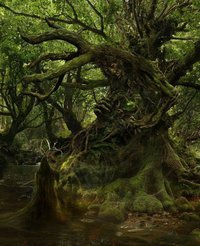|
G is for Gnosis
"Altered states of consciousness are the key to magical powers. The particular state of mind required has a name in every tradition: No-Mind. In this book it will be known as Gnosis. Methods for achieving gnosis can be divided into two types. In the inhibitory mode, the mind is progressively silenced until only a single object of concentration remains. In the excitatory mode, the mind is raised to a very high pitch of excitement while concentration on the objective is raised. Thus strong inhibition and strong excitation end up creating the same effect - the one-pointed consciousness, or gnosis." Liber LUX Saxon shamen knew this symbolically as Fire and Ice. See H is for Here Be Dragons Here is another interpretation of 'gnosis'; "Gnosis is similar to the Polynesian concept of mana, or the Eastern concept of chi. While all creatures have some spiritual component, Garou can consciously control and use it. Garou are quite literally half-spirit already and Gnosis reflects how connected they are to their other half. Gnosis can't be precisely measured, but if you think of it like water, it makes comprehending the difference between a Garou and a human easier. A human has a cupful to last a lifetime, a Garou has access to an endlessly replenishing river. Gnosis can be used to bribe spirits, activate fetishes (magical artifacts) and Gifts, and to enter the Umbra. Creatures without enough Gnosis generally cannot perceive or enter the Umbra. Gnosis is a renewable, but dwindling, resource. Garou can regain it at sacred sites, by meditating, or bargaining with spirits. Sacred sites provide Gnosis, but if they become defiled, it can corrupt the Garou, or there simply may be no more available. The water analogy works well here. They need water, but they need to protect their sources because drinking tainted water may make them sick, and if they aren't careful, their well may go dry." http://whitewolf.wikia.com/wiki/Werewolf:_The_Apocalypse Gnosticism I have not yet finished this entry G is for Gnosis. I have yet to write my commentary. It is not timetabled to be submitted until 6.4.2012
0 Comments
Leave a Reply. |
G is for:
Gaia Gate Ritual Gnosis Gris Gris G categories
All
Contemplation Dionysis + Gnosis = Diognosis Gaian + Gnosis = Gaianosis = Genesis Writing this blog has inspired me to do an essay on Druidism, which will be posted in D is for as and when I get around to it.
"Pan, the god of woods and fields, of flocks and shepherds, dwelt in grottos, wandered on the mountains and in valleys, and amused himself with the chase or in leading the dances of the nymphs. He was fond of music, and as we have seen, the inventor of the syrinx, or shepherd's pipe, which he himself played in a masterly manner. Pan, like other gods who dwelt in forests, was dreaded by those whose occupations caused them to pass through the woods at night, for the gloom and lonliness of such scenes dispose the mind to superstitious fears. Hence sudden fright without any visible cause was ascribed to Pan, and called a Panic terror. As the name of the god signifies all, Pan came to be considered a symbol of the universe and personification of Nature; and later still to be regarded as a representation of all the gods of paganism itself." source “Cernunnos the male horned god of the Iron age Celts. Symbol of the Hunter and the Hunted. Also known as Herne the Hunter. Modern Druidry, which derives from Celtic culture, honors Cernunnos in his ancient Celto-European form as the guardian of the forests, the defender of the animal tuatha (tribes), the source of the deep forest wisdom, and the masculine half of creative energy. His restorative work in the cycle of the year is particularly celebrated at Beltaine, and is often paired with one or another of the female deities in her maiden aspect. Druids may call upon him in reference to vital, non-violent masculine divinity.” source |


 RSS Feed
RSS Feed


